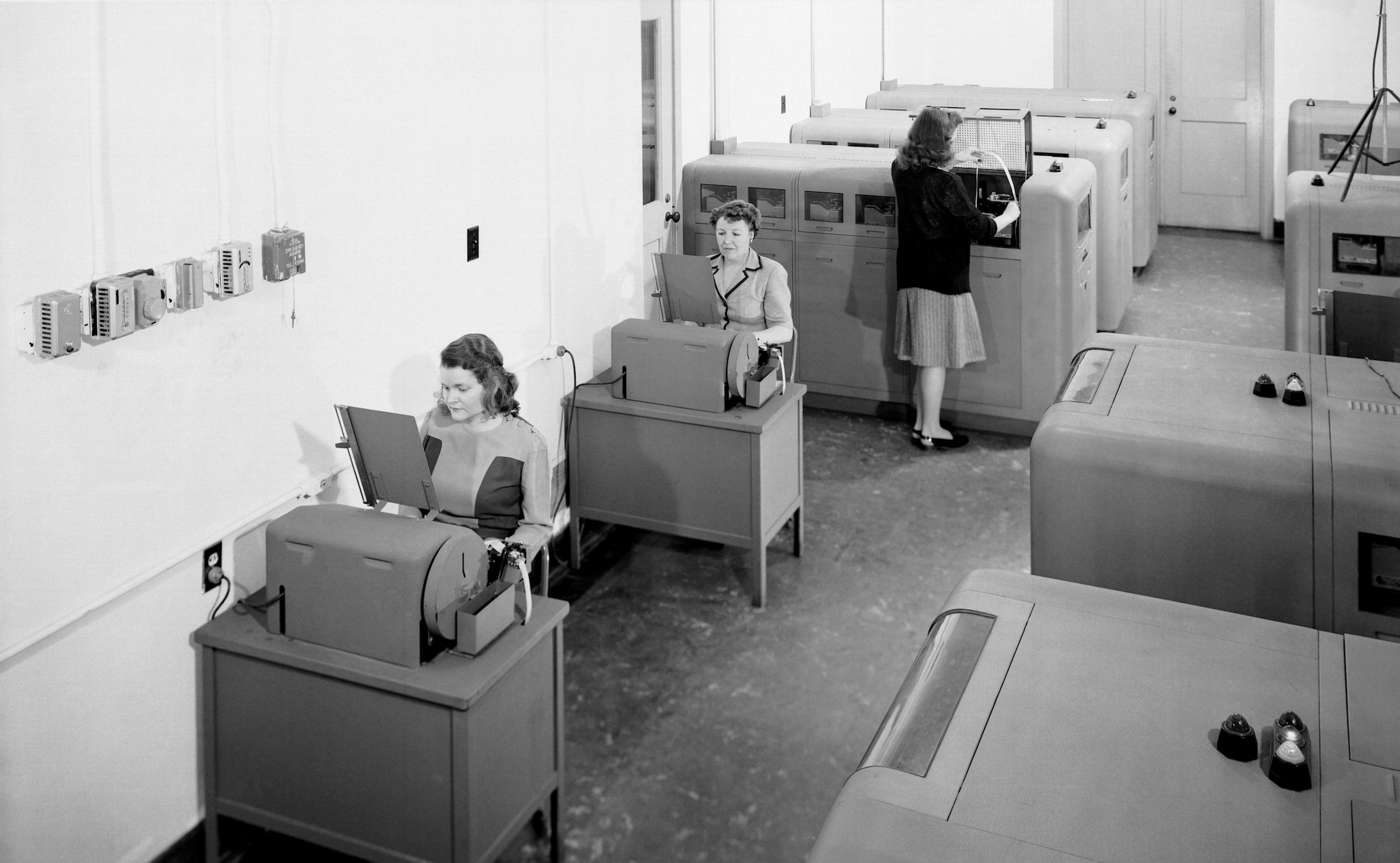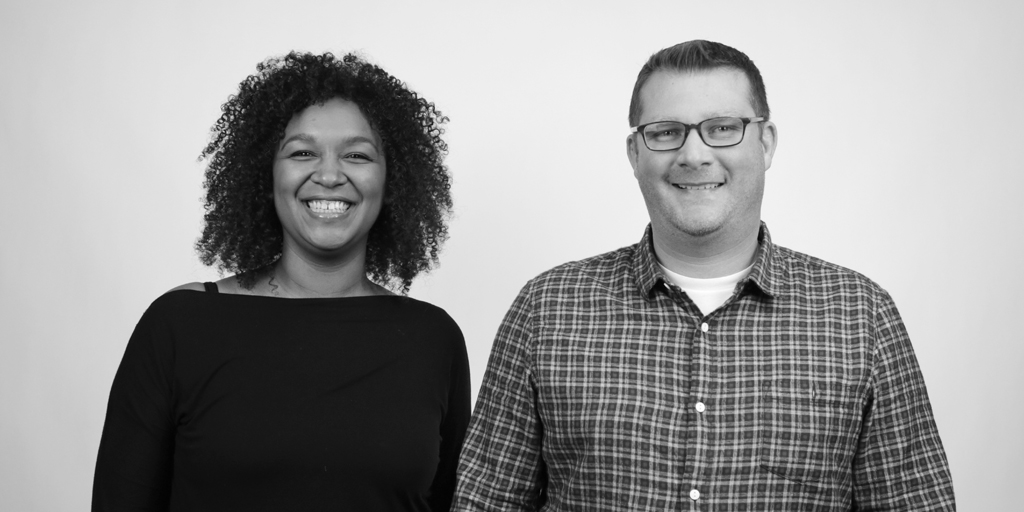
NASA Jet Propulsion Laboratory employees, 1940s
In 1953, a woman named Elsie Shutt accepted a job as a programmer at defense contractor Raytheon, where she was astonished to find that the programming workforce was about 50% women and 50% men. “It really amazed me that these men were programmers,” she said later, “because I thought it was women’s work!”
Wait. What?
In a February New York Times Magazine feature, “The Secret History of Women in Coding,” journalist Clive Thompson uncovers the little-known history of the women who shaped the early software industry, and disentangles the complex of web of social, cultural and economic factors that led to programming becoming a field dominated by men.
The feature is an excerpt from Thompson’s forthcoming book, “Coders: The Making of a New Tribe and the Remaking of the World,” out March 26, 2019. Drawn from hundreds of interviews with developers, Coders is an immersive account of who coders are, what they do and how their work shapes our reality.
We sat down with Thompson, a columnist for Wired and a longtime contributor to Smithsonian and The New York Times Magazine, to learn more about the history of women in software – and why that history has been largely forgotten.
Software Pioneers
In the 1940s, digital computers finally became a practical reality. “At the time,” writes Thompson in The New York Times Magazine, “men in the computing industry regarded writing code as a secondary, less interesting task. The real glory lay in making the hardware.” The term software had yet to be invented.
As Thompson recounts, the Electronic Numerical Integrator and Computer (Eniac), the first programmable digital computer in the US, weighed more than 30 tons and included over 17,000 vacuum tubes. “Merely getting it to work was seen as the heroic, manly engineering feat,” Thompson writes. “In contrast, programming it seemed menial, even secretarial. Women had long been employed in the scut work of doing calculations.”
But these women were software pioneers. They were “among the first coders,” Thompson writes, “to discover that software never works right the first time — and that a programmer’s main work, really, is to find and fix the bugs.”
Computer scientists like Grace Hopper, Thompson says, also played a pivotal role in developing computing languages closer in structure to the words we use, thereby making programming more accessible and intuitive to people not familiar with binary code.

NASA Langley Research Center employees, 1947
In the ’50s and ’60s, the number of coding jobs rose sharply as companies began relying on software for payroll, data analysis and other applications. Women continued to be hired as programmers; some executives, Thompson notes, argued that a woman’s presumed expertise in knitting, cooking, sewing and other meticulous domestic tasks would make her a superior programmer. Thompson calls coding in the ’50s and ’60s “the rare white-collar occupation in which women could thrive.” But, of course, there were limits.
Elsie Shutt, the Raytheon programmer, was required by state law to leave her job when she had a child in 1957. Companies were hiring full-time female coders, but part-time work wasn’t on offer, even for highly qualified programmers. Shutt founded a code-producing consultancy and hired stay-at-home mothers to work part time. If they didn’t know how to code, she trained them. “What it turned into,” Shutt would reflect later, according to the New York Times Magazine feature, “was a feeling of mission, in providing work for women who were talented and did good work and couldn’t get part-time jobs.”
“You Can’t Do That”
By the 1980s, Thompson writes, early women programmers had largely been forgotten, and pop culture was sending a very different message: Computers were for men. The cultural model for a coder had changed. No longer a single woman or working mother, the prototypical coder was now — to use Thompson’s phrase — “a nerdy guy.” It’s a calcified stereotype that sticks with us. So what changed?
Part of the shift began happening as early as the ’60s and ’70s. With more men becoming programmers, women began to notice that their advancement opportunities were evaporating. Thompson explained what many women told him: “The time came for a promotion. The time came for more money, and she didn’t get it. When she asked the boss why, he said, ‘Well, you know, you’re a woman, and he’s a guy. And he’s going to need to look after his wife and kids.’”
As coding became more central to business operations, a demand grew for programmers who could stay late to maintain uptime. Women coders found that their bosses discouraged them – and sometimes even forbade them – from working late at night. As Thompson tells us, “They heard, ‘Well, you can’t do that. Yeah, you’re a coder, but you can’t stay late at night when the guys were there. It’s too dangerous.’ And there was also a sense that it was scandalous… A single woman working late at night with men who may or may not be married.”
As absurd as such logic might sound, these social mores created and enforced real barriers to women’s success, and not just in computer science. “One of the barriers for female lawyers advancing in the ’60s and ’70s,” Thompson says, “was you couldn’t work late at night because the male partners were married, and you couldn’t be alone with them.”
As computer science drew more professional respect and cultural attention, it ceased to be considered “women’s work.” We asked Thompson whether, if programming had continued to be dismissed as “scut work,” akin to typing or taking messages, the industry would comprise more women today.
“Quite possibly yes,” he says. “If programming had remained sort of a menial task, then it may well be that men in power would have left it to the women. Certainly, that is what many women who were around back then said to me. And they watched it happen.”
The New Coder
It wasn’t only social conventions that barred women’s access to coding. Somewhat counterintuitively, the increasing prevalence of personal computers in the home led to greater gender imbalance in schools and at work. As the first generation of personal computers — the Commodore 64 and the TRS-80 — emerged, teenagers began learning to program in their spare time. Thompson himself was one of these self-taught coders for whom personal computers became a gateway to more sophisticated programming: “I liked video games,” he says, “and I wanted to make video games and show them to my friends. You can learn a lot that way.”
But most of the teens teaching themselves to code were boys. In the mid-1980s, when college freshman began arriving on campus as proficient programmers, they were mostly male, too.
By the 1990s, Jane Margolis, now a senior researcher in the UCLA School of Education and Information Studies, and Allan Fisher, then associate dean of the computer science school at Carnegie Mellon, were looking into why women’s enrollment in computer science was so low.
In a study of 100 computer science undergraduates at Carnegie Mellon, Margolis found that young men had received much more exposure to computers than girls had; for example, boys were twice as likely to receive computers as gifts from their parents than girls were. Boys also received instruction and encouragement at home and in the classroom, but the same wasn’t true for girls.
Margolis told Thompson that every female computer science student at Carnegie Mellon reported that her father had taught her brother basic programming skills – but that she “had to fight her way through to get some attention.” Margolis and Fisher later published their research in a landmark book, “Unlocking the Clubhouse: Women in Computing.”
As Thompson writes in “The Secret History of Women in Coding,” “Girls, even the nerdy ones, picked up these cues and seemed to dial back their enthusiasm accordingly. These were pretty familiar roles for boys and girls, historically: Boys were cheered on for playing with construction sets and electronics kits, while girls were steered toward dolls and toy kitchens.”
An environment had emerged in which the students most likely to be successful were those who had already been exposed to coding – meaning, largely, men. And even as academic doors were closing to them, women were facing an uphill battle in corporate America, which had an increasingly specific — and exclusionary — vision of what a successful programmer looks like.
Unconscious Bias in Tech
By the 1990s and early 2000s, Thompson writes, “the pursuit of ‘culture fit’ was in full force, particularly at start-ups… Founders looked to hire people who were socially and culturally similar to them… Because almost everyone in charge was a white or Asian man, that was the model for whom to hire; managers recognized talent only when it walked and talked as they did.”
It isn’t just women who suffer the effects of unconscious bias, of course. A 2016 study showed that people of color were much more likely to be offered jobs if they “whitened” their names (for instance, by using “L. Smith” instead of “Latisha Smith” or “Wade” instead of “Wei”).
“Women’s contributions to open-source software are accepted more often than men’s are, but only if their gender is unknown.”
In its 2017 cover story, “Why is Silicon Valley So Awful to Women?”, The Atlantic reported: “Women not only are hired in lower numbers than men are; they also leave tech at more than twice the rate men do… Studies show that women who work in tech are interrupted in meetings more often than men. They are evaluated on their personality in a way that men are not. They are less likely to get funding from venture capitalists… And in a particularly cruel irony, women’s contributions to open-source software are accepted more often than men’s are, but only if their gender is unknown.”
Ellen Pao, a former junior partner at venture-capital firm Kleiner Perkins Caufield & Byers, famously filed a gender discrimination suit against Kleiner Perkins in 2012, training a spotlight on gender imbalance in Silicon Valley. In 2017, she told The New Yorker that while women were still vastly outnumbered in tech in the ’90s, the culture was nowhere near as competitive, money-driven or exclusionary as it became.
The environment, Pao says, changed after early venture-capital firms started investing in tech. “They happened to all be white guys who had graduated from the same handful of élite colleges,” Pao told The New Yorker. “And they tended to make investments in new firms started by people they knew, or by people who were like them.” Facebook’s 2012 IPO cemented Silicon Valley’s reputation as “the place to make a quick fortune,” Pao says, and tech began competing with hedge funds and financial institutions for the sharpest college graduates – further shifting the culture.
The result is a dramatically lopsided industry. According to the Bureau of Labor Statistics, only 26% of employees in “computer and mathematical occupations” in the US are women. Black employees represent just over 8% of this workforce, while Latinxs represent 7.5%.
If this sounds bad, brace yourself, because the numbers are even worse at the household names. In 2017, Recode reported that only 15-20% of technical employees at Google, Facebook and Twitter were women, while Black and Latinx employees made up a measly 1-4% of the technical workforce at these companies.
Not all bias is unconscious, though. In the summer of 2017 (yes, 2017), a Google employee suggested in an internal email that women are inherently worse programmers than men, citing bogus sociobiology to explain away the gender imbalance in programming. Although Google fired the employee for violating the company code of conduct, plenty of male Googlers defended him, emphasizing the deep-running assumption among many that the programming workforce reflects a pure meritocracy.
“If biology were the reason [for the gender imbalance], it would be impossible to explain why women were so prominent in the early years of American programming, when the work could be, if anything, far harder.”
Thompson’s response to those who argue that biology is the reason we don’t have more women in coding is unambiguous: “If biology were the reason,” he writes in “The Secret History of Women in Coding,” “it would be impossible to explain why women were so prominent in the early years of American programming, when the work could be, if anything, far harder than today’s programming. It was an uncharted new field, in which you had to do math in binary and hexadecimal formats, and there were no helpful internet forums, no Google to query, for assistance with your bug. It was just your brain in a jar, solving hellish problems.”
“Shifting the Culture”
In a marked contrast to the United States, according to studies Thompson cites in his feature, women make up about 40% of students studying computer science and related fields in India. In Malaysia, 52% of undergraduate computer science majors are women. (So much for biology.)
Thompson, following other researchers, argues that parental encouragement and social norms are key differentiators in countries where more women pursue programming: “When you do find women in coding today, they often have some really good encouragement and role models along the way… They had parents and mentors who said, ‘Yeah, you should do this. This is great.’ Encouragement is a really, really big deal.”
“In other countries where it is seen as normal for women to do coding, they do a lot more coding.”
When more girls and women study programming, the concept becomes normalized. In countries where more women pursue coding careers, Thompson says, “there might be a bunch of reasons why that is. But the bottom line is that it just doesn’t seem weird. In other countries where it is seen as normal for women to do coding, they do a lot more coding.”
Thompson credits organizations like Black Girls Code, dedicated to empowering women of color to succeed in STEM fields, with opening people’s eyes, including the next generation of potential programmers: “We need to make sure the gateway [to learning to code] stays open,” he says. “It’s a big factor that goes alongside direct encouragement. You want to expose as many kids as possible who might otherwise feel pushed away from [coding]. It really is heartening that organizations and after-school programs are tackling this, because it isn’t something you solve entirely through school.”
Meanwhile, more girls are learning to code in school. In 2012, according to research by UCLA’s Linda Sax, the percentage of female undergraduates planning to major in computer science began to rise at rates not seen since the decline of the mid-1980s. Culturally, the history of women in STEM is rising in profile; Margot Lee Shetterly’s bestselling book, “Hidden Figures,” was made into a high-profile movie about NASA’s human computers, including Katherine Johnson.
But the veteran women coders Thompson interviewed remain skeptical: “What is harder is shifting the culture of the industry at large,” he writes, “particularly the reflexive sexism and racism still deeply ingrained in Silicon Valley.”
With more people of all genders flooding into the industry, Thompson cautions, organizations will need to push back against a temptation to divide programming into white- and pink-collar segments: front-end development for women; block chain and AI for men.
No Silver Bullet
In talking with organizations that have succeeded in increasing the number of women in their ranks, Thompson found that there was no single solution for gender equality, no one policy capable of reversing decades of structural discrimination.
As Thompson told us, “I asked Jane Margolis and Allan Fisher [who researched the status of women in coding at Carnegie Mellon], ‘So, you went from a small minority of women to 30-40% in a couple of years. How did you do that?’ And they said, ‘Well, here’s the eight or nine things we did.’ And no one of them was the single silver bullet.”
Thompson says that Margolis and Fisher tried everything they could think of to attract more women. “Ranging from things that seem obvious to ones that seem trivial,” he says. “And in some respects, it actually makes it a harder story to write and a harder story to read, because you want there to be a single answer. And it’s not there.”
Even for Thompson, the full story of the rise and decline — and, fingers crossed, the new rise — of the woman coder remains complex and subject to interpretation. “It’s still a puzzle to be understood,” he says. “I mean, I can tell the best story I can based on research, and the work of historians, and the woman I spoke to who lived through it. That’s how we understand why and how this happened.”
We asked Thompson what drew him to the little-known history of women coders, and why he felt their story was so important. “American society is always good at discarding recent history,” he says. “Telling stories of the heroic past is a good way to make sure we know what happened.”
Clive Thompson’s new book, “Coders: The Making of a New Tribe and the Remaking of the World,” out March 26, 2019, is an in-depth look at the past, present and future of programmers. Thompson is a Wired columnist, a contributing writer for The New York Times Magazine, and the author of “Smarter Than You Think: How Technology is Changing Our Minds for the Better.” You can preorder his new book here.
Jama Software is committed to achieving greater diversity and nurturing a more inclusive Portland tech community. We have taken the TechTown Diversity Pledge, a commitment by Portland tech companies to cultivate a diverse talent pipeline and foster inclusive work environments.







